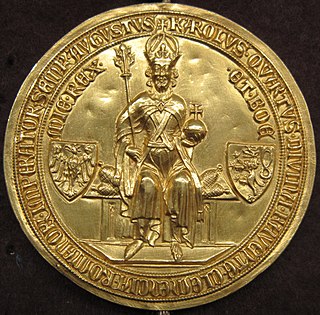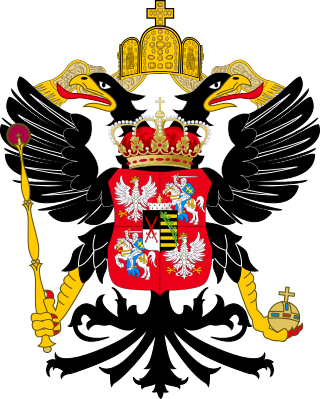Related Research Articles

The Holy Roman Empire, also known, after 1512, as the Holy Roman Empire of the German Nation was a political entity, usually headed by the Holy Roman Emperor in Central and Western Europe. It developed in the Early Middle Ages and continued until its dissolution in 1806 during the Napoleonic Wars.

The prince-electors, or electors for short, were the members of the electoral college that elected the emperor of the Holy Roman Empire.

Regensburg is a city in eastern Bavaria, at the confluence of the Danube, Naab and Regen rivers. It is the capital of the Upper Palatinate subregion of the state in the south of Germany. With more than 150,000 inhabitants, Regensburg is the fourth-largest city in the State of Bavaria after Munich, Nuremberg and Augsburg. From its foundation as an imperial Roman river fort, the city has been the political, economic and cultural centre of the surrounding region; it is still known in the Romance languages as a cognate of its Latin name of "Ratisbona". Later, under the rule of the Holy Roman Empire, it housed the Perpetual Diet of Regensburg.

Ferdinand I was Holy Roman Emperor from 1556, King of Bohemia, Hungary, and Croatia from 1526, and Archduke of Austria from 1521 until his death in 1564. Before his accession as Emperor, he ruled the Austrian hereditary lands of the House of Habsburg in the name of his elder brother, Charles V, Holy Roman Emperor. Also, he often served as Charles' representative in the Holy Roman Empire and developed encouraging relationships with German princes. In addition, Ferdinand also developed valuable relationships with the German banking house of Jakob Fugger and the Catalan bank, Banca Palenzuela Levi Kahana.

In the Holy Roman Empire, the collective term free and imperial cities, briefly worded free imperial city, was used from the fifteenth century to denote a self-ruling city that had a certain amount of autonomy and was represented in the Imperial Diet. An imperial city held the status of Imperial immediacy, and as such, was subordinate only to the Holy Roman Emperor, as opposed to a territorial city or town which was subordinate to a territorial prince – be it an ecclesiastical lord or a secular prince.

The Reichskammergericht was one of the two highest judicial institutions in the Holy Roman Empire, the other one being the Aulic Council in Vienna. It was founded in 1495 by the Imperial Diet in Worms. All legal proceedings in the Holy Roman Empire could be brought to the Imperial Chamber Court, except if the ruler of the territory had a so-called privilegium de non appellando, in which case the highest judicial institution was found by the ruler of that territory. Another exception was criminal law in which the Imperial Chamber Court could intervene only if basic procedural rules had been violated.
In politics, a diet is a formal deliberative assembly. The term is used historically for deliberative assemblies such as the German Imperial Diet, as well as a designation for modern-day legislative bodies of certain countries and states such as the National Diet of Japan, or the German Bundestag, the Federal Diet.

The Golden Bull of 1356 was a decree issued by the Imperial Diet at Nuremberg and Metz headed by the Emperor Charles IV which fixed, for a period of more than four hundred years, important aspects of the constitutional structure of the Holy Roman Empire. It was named the Golden Bull for the golden seal it carried.

The Aulic Council was one of the two supreme courts of the Holy Roman Empire, the other being the Imperial Chamber Court. It had not only concurrent jurisdiction with the latter court, but in many cases exclusive jurisdiction, in all feudal processes, and in criminal affairs, over the immediate feudatories of the Emperor and in affairs which concerned the Imperial Government. The seat of the Aulic Council was at the Hofburg residence of the Habsburg emperors in Vienna.

Karl Theodor Anton Maria von Dalberg was a German bishop and statesman. In various capacities, he served as Prince-Archbishop of Regensburg, Arch-Chancellor of the Holy Roman Empire, Bishop of Constance and Worms, Prince-Primate of the Confederation of the Rhine and Grand Duke of Frankfurt.

German mediatisation was the major territorial restructuring that took place between 1802 and 1814 in Germany and the surrounding region by means of the mass mediatisation and secularisation of a large number of Imperial Estates. Most ecclesiastical principalities, free imperial cities, secular principalities, and other minor self-ruling entities of the Holy Roman Empire lost their independent status and were absorbed into the remaining states. By the end of the mediatisation process, the number of German states had been reduced from almost 300 to just 39.

The Reichsdeputationshauptschluss, sometimes referred to in English as the Final Recess or the Imperial Recess of 1803, was a resolution passed by the Reichstag of the Holy Roman Empire on 24 March 1803. It was ratified by the Emperor Francis II and became law on 27 April. It proved to be the last significant law enacted by the Empire before its dissolution in 1806.

Prince of the Holy Roman Empire was a title attributed to a hereditary ruler, nobleman or prelate recognised as such by the Holy Roman Emperor.
The Diet of Speyer or the Diet of Spires was a Diet of the Holy Roman Empire held in 1529 in the Imperial City of Speyer. The Diet condemned the results of the Diet of Speyer of 1526 and prohibited future reformation. It resulted in the Protestation at Speyer.
The Diet of Speyer or the Diet of Spires was an Imperial Diet of the Holy Roman Empire in 1526 in the Imperial City of Speyer in present-day Germany. The Diet's ambiguous edict resulted in a temporary suspension of the Edict of Worms and aided the expansion of Protestantism. Those results were repudiated in the Diet of Speyer (1529).
The Colloquy of Regensburg, historically called the Colloquy of Ratisbon, was a conference held at Regensburg (Ratisbon) in Bavaria in 1541, during the Protestant Reformation, which marks the culmination of attempts to restore religious unity in the Holy Roman Empire by means of theological debate between the Protestants and the Catholics.

An imperial vicar was a prince charged with administering all or part of the Holy Roman Empire on behalf of the emperor. Later, an imperial vicar was invariably one of two princes charged by the Golden Bull with administering the Holy Roman Empire during an interregnum.

The Imperial Diet was the deliberative body of the Holy Roman Empire. It was not a legislative body in the contemporary sense; its members envisioned it more like a central forum where it was more important to negotiate than to decide.

The Perpetual Diet of Regensburg or the Eternal Diet of Regensburg, also commonly called in English the Perpetual Diet of Ratisbon, from the city's Latin name, was a session of the Imperial Diet (Reichstag) of the Holy Roman Empire that sat continuously from 1663 to 1806 in Regensburg in present-day Bavaria, Germany. Previously, the Diet had been convened in different cities but, beginning in 1594, it met only in the town hall in Regensburg. On 20 January 1663, the Diet convened to deal with threats from the Ottoman Empire. Since the Peace of Westphalia in 1648, the Holy Roman Emperor had been formally bound to accept all decisions made by the Diet. Hence, out of fear that the Emperor would disregard the Diet's role by not calling sessions, it never dissolved and became a perpetual diet. Therefore, no final report of its decisions, known as a Recess, could be issued, and that of the preceding diet, issued in 1654, was dubbed the Youngest Recess. From 1663 until the 1684 Truce of Ratisbon, the diet gradually developed into a permanent body.
A Reichskrieg was a war fought by the Holy Roman Empire as a whole against a common enemy. After the Peace of Westphalia in 1648, a Reichskrieg was a formal state of war that could only be declared by the Imperial Diet.
References
- 1 2 Leopold von Ranke, History of the Reformation in Germany, tr. Sarah Austin, Philadelphia: Lea and Blanchard, 1844, Preface, p. iii, note.
- ↑ "Germany", Charles F. Partington, The British Cyclopædia of Literature, History, Geography, Law, and Politics, London: Orr and Smith, 1836, volume 2, p. 143: "All the decrees of a diet were called a recess of the empire."
- ↑ E. Br., "Diet", Encyclopædia Britannica 11th ed., 1910/11, volume 8, p. 212: "The term applied to the acta of the diet, as formally compiled and enunciated at its dissolution".
- ↑ "Diet", New Encyclopædia Britannica 15th ed., 2002, volume 4, p. 86: "All the decisions of the Diet forming the resolution were called the 'recess of the empire' (Reichsabschied)".
- ↑ Friedrich Heer, tr. Janet Sondheimer, The Holy Roman Empire, London: Weidenfeld/New York: Praeger, 1968, OCLC 405027, p. 265: "the Reichsabschiede (decisions made by the imperial diet before its temporary suspension)."
- ↑ Heer, p. 267.